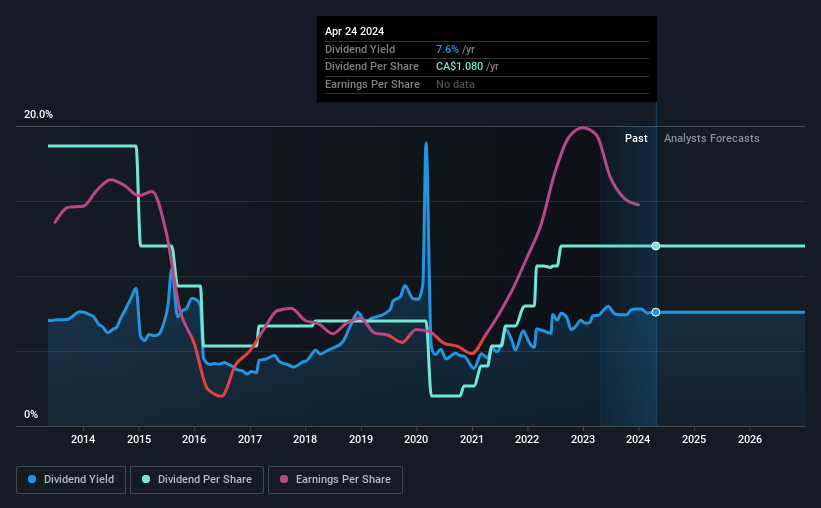Stock Analysis
- Canada
- /
- Oil and Gas
- /
- TSX:FRU
Freehold Royalties Ltd. (TSE:FRU) Is About To Go Ex-Dividend, And It Pays A 7.6% Yield

Regular readers will know that we love our dividends at Simply Wall St, which is why it's exciting to see Freehold Royalties Ltd. (TSE:FRU) is about to trade ex-dividend in the next 4 days. Typically, the ex-dividend date is one business day before the record date which is the date on which a company determines the shareholders eligible to receive a dividend. The ex-dividend date is an important date to be aware of as any purchase of the stock made on or after this date might mean a late settlement that doesn't show on the record date. Meaning, you will need to purchase Freehold Royalties' shares before the 29th of April to receive the dividend, which will be paid on the 15th of May.
The company's upcoming dividend is CA$0.09 a share, following on from the last 12 months, when the company distributed a total of CA$1.08 per share to shareholders. Looking at the last 12 months of distributions, Freehold Royalties has a trailing yield of approximately 7.6% on its current stock price of CA$14.23. Dividends are an important source of income to many shareholders, but the health of the business is crucial to maintaining those dividends. As a result, readers should always check whether Freehold Royalties has been able to grow its dividends, or if the dividend might be cut.
View our latest analysis for Freehold Royalties
Dividends are usually paid out of company profits, so if a company pays out more than it earned then its dividend is usually at greater risk of being cut. Freehold Royalties distributed an unsustainably high 123% of its profit as dividends to shareholders last year. Without more sustainable payment behaviour, the dividend looks precarious. A useful secondary check can be to evaluate whether Freehold Royalties generated enough free cash flow to afford its dividend. It paid out 79% of its free cash flow as dividends, which is within usual limits but will limit the company's ability to lift the dividend if there's no growth.
It's disappointing to see that the dividend was not covered by profits, but cash is more important from a dividend sustainability perspective, and Freehold Royalties fortunately did generate enough cash to fund its dividend. Still, if the company repeatedly paid a dividend greater than its profits, we'd be concerned. Extraordinarily few companies are capable of persistently paying a dividend that is greater than their profits.
Click here to see the company's payout ratio, plus analyst estimates of its future dividends.

Have Earnings And Dividends Been Growing?
Businesses with strong growth prospects usually make the best dividend payers, because it's easier to grow dividends when earnings per share are improving. If earnings decline and the company is forced to cut its dividend, investors could watch the value of their investment go up in smoke. It's encouraging to see Freehold Royalties has grown its earnings rapidly, up 49% a year for the past five years.
The main way most investors will assess a company's dividend prospects is by checking the historical rate of dividend growth. Freehold Royalties's dividend payments per share have declined at 4.3% per year on average over the past 10 years, which is uninspiring. Freehold Royalties is a rare case where dividends have been decreasing at the same time as earnings per share have been improving. It's unusual to see, and could point to unstable conditions in the core business, or more rarely an intensified focus on reinvesting profits.
Final Takeaway
Is Freehold Royalties an attractive dividend stock, or better left on the shelf? Growing earnings per share and a normal cashflow payout ratio is an ok combination, but we're concerned that the company is paying out such a high percentage of its income as dividends. Overall we're not hugely bearish on the stock, but there are likely better dividend investments out there.
However if you're still interested in Freehold Royalties as a potential investment, you should definitely consider some of the risks involved with Freehold Royalties. Our analysis shows 1 warning sign for Freehold Royalties and you should be aware of it before buying any shares.
A common investing mistake is buying the first interesting stock you see. Here you can find a full list of high-yield dividend stocks.
Valuation is complex, but we're helping make it simple.
Find out whether Freehold Royalties is potentially over or undervalued by checking out our comprehensive analysis, which includes fair value estimates, risks and warnings, dividends, insider transactions and financial health.
View the Free AnalysisHave feedback on this article? Concerned about the content? Get in touch with us directly. Alternatively, email editorial-team (at) simplywallst.com.
This article by Simply Wall St is general in nature. We provide commentary based on historical data and analyst forecasts only using an unbiased methodology and our articles are not intended to be financial advice. It does not constitute a recommendation to buy or sell any stock, and does not take account of your objectives, or your financial situation. We aim to bring you long-term focused analysis driven by fundamental data. Note that our analysis may not factor in the latest price-sensitive company announcements or qualitative material. Simply Wall St has no position in any stocks mentioned.
About TSX:FRU
Freehold Royalties
Freehold Royalties Ltd. engages in the acquiring and managing royalty interests in the crude oil, natural gas, natural gas liquids, and potash properties in Western Canada and the United States.
Adequate balance sheet and fair value.

